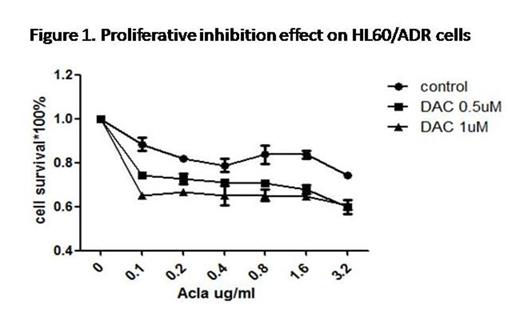Abstract
Background and objectives The DNA methyltransferase inhibitors decitabine represent archetypal drugs for epigenetic cancer therapy. One alternative approach for the treatment of (Acute Myelocytic Leukemia) AML is the use of hypomethylating agents, including the 5-aza-2-deoxycytidine (decitabine; DAC) and other epigenetic regulators. However, the exact mechanism of DAC for drug resistance AML remains poorly understood. We conducted this study to explore how DAC regulated the sensitivity to adriamycin and aclacinomycin of AML cell line HL60/ADR and assessed the efficacy and safety of decitabine-based induction treatment patients with refractory acute myeloid leukemia.
Methods In this study, we analyzing cell proliferation of HL60, HL60/ADR and KG1-¦Á cells treated by DAC against control group detected with MTS assay. Then the changes of genes methylation were determined using Methylation specific PCR (MSP), stained with anti-CD11b, before being analyzed for cell markers with flow cytometric analysis. The cell protein levels were checked with Western blotting as described elsewhere. Data were collected from refractory acute myelogenous leukemia (AML) patients treated with homoharringtonine, cytarabine, and aclarubicin after decitabine (D-HAA). Control group consisted of fludarabine, cytarabine with or without Granulocyte Colony-Stimulating Factor between 2012 and 2014.
Results Different dose of DAC had proliferative inhibition effect on HL-60 cells, with time-dose dependent relationship. But the proliferative inhibition of DAC in KG1-¦Á and HL-60/ADR cells was not so effective. After been treated with 1¦ÌM DAC for 72 hours, HL-60/ADR cells were cultured with 0.5µg/ml adriamycin 1 hour. Adriamycin positive cells in DAC group were higher than control group, and the proliferative inhibition effect of adriamycin (P<0.001) and aclacinomycin (P<0.001) on HL60/ADR cells was increased (Figure 1). 1¦ÌM DAC significantly induced expression of CD11b on HL-60/ADR and KG1-¦Á cells, accompanied by cellular changes of differentiation (decreased nuclear¨Ccytoplasmic ratio, nuclear condensation, segmentation or lobulation, cytoplasmic granulation or vacuolization). Followed the increased the sensitivity of adriamycin, DNMT1 and SPRPs gene methylation was down-regulated. And ¦Â-catenin protein in nuclear was depressed after treatment of DAC. We enrolled 75 patients, of whom 71 were included in the intention-to-treat analysis. 65.2% patients in the D-HAA group achieved complete remission versus 29.2% in the FA/FLAG group (P=0.031). 2-year disease-free survival and overall survival were better in D-HAA group than FA/FLAG group (P=0.020, P=0.025; Figure 2).
Conclusion These findings provide evidence for clinic protocols using DAC to reversed drug resistance in refractory AML cell.
No relevant conflicts of interest to declare.
Author notes
Asterisk with author names denotes non-ASH members.



